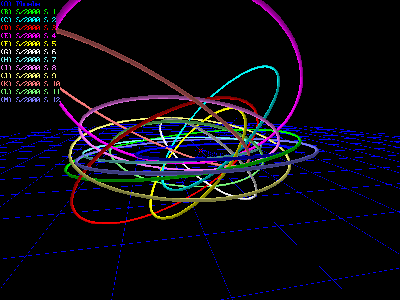
ESO Press office web page for ESO press release (26 Oct 2000).
McMaster University press release (26 Oct 2000).
Cornell University press release (26 Oct 2000).
http://www.astro.ubc.ca/people/gladman/saturn

 UPDATE (January 2003) :
Between August and December 2002 all 12 of the new satellites which
received designations in 2000 have been recovered by our team at a variety
of telescopes around the world. As a result, all satellites have now
been observed at 3 oppositions. Only minor modifications of their
orbits have occurred as a result of these tracking observations (see
orbital information links at the bottom of this page). These twelve
satellites have now reached a stage of orbital precision to receive
full (Roman numeral) designations by the International Astronomical Union.
UPDATE (January 2003) :
Between August and December 2002 all 12 of the new satellites which
received designations in 2000 have been recovered by our team at a variety
of telescopes around the world. As a result, all satellites have now
been observed at 3 oppositions. Only minor modifications of their
orbits have occurred as a result of these tracking observations (see
orbital information links at the bottom of this page). These twelve
satellites have now reached a stage of orbital precision to receive
full (Roman numeral) designations by the International Astronomical Union.
Old (discovery) PRESS RELEASE, July 9 2001 / Communique de press, 9 juillet 2001
As of Jan 30/2003, 12 new saturnian satellites have been discovered and
announced (see IAU telegrams below).
These satellites all belong to the `irregular' class,
meaning that thier orbits are highly inclined with respect to the
planet's equator (and ring plane), and may be significantly non-circular.
Independent orbital determinations
(B. Marsden, MPC; R. Jacobson, JPL; B. Gray, Project Pluto) have shown
that the new satellites split into three or four `groups'. The first group
contains 4 retrograde orbits like those of Phoebe, one other satellite is
isolated on a retrograde orbit, while the 7 others form
two new prograde cluster (that is, which go around the planet in the same
sense that it spins).
The situation of Saturn thus seems to resemble that of Jupiter, which also
has retrograde and prograde satellites, concentrated into clusters.
Technical astrometric and orbital information is available at the
bottom of this page
IAU Circular 7512 (Oct 26, 2000) (Discovery of S 1 and S 2)
IAU Circular 7513 (Oct 26, 2000) (Discovery of S 3, and S 4)
IAU Circular 7521 (Nov 18, 2000) (Discovery of S 5 and S 6)
IAU Circular 7538 (Dec 7, 2000) (Discovery of S 7, S 8, and S 9)
IAU Circular 7539 (Dec 7, 2000) (Discovery of S 10)
IAU Circular 7545 (Dec 19, 2000) (Discovery of S 11)
IAU Circular 7548 (Dec 23, 2000) (Discovery of S 12)
 IMAGES
IMAGES
Animation of S/2000 S 2.
Animation of S/2000 S 4.
Discovery Image of S/2000 S 1 /
Image de découverte de S/2000 S 1
Discovery Image of S/2000 S 2 /
Image de découverte de S/2000 S 2
Offset plot (postscript file) of saturnian irregulars.
Photo (tif file) of 4 team members (Gladman/Petit/Holman/Kavelaars, L to R)
In 1997 a group of astronomers reported the discovery of the first two known
irregular moons of the giant planet Uranus and in 1999 they added to that
total with the discovery of three additional satellites.
Beginning October 26/2000 the most recent discovery was announced. This time
the focus of the search was Saturn, revealing four
new irregular moons of that planet, which has since grown to twelve
announced satellites in 2000.
Prior to this search Saturn was thought to have only one satellite of
this class (Phoebe).
The newly-discovered satellites are small (less than 50 km across)
and likely icy moons, the remnants of a capture event long ago.
The satellites orbit Saturn at distances of roughly 10-20 million kilometers
from planet.
Coupled with their 1999 discoveries, this group is responsible for the
discovery of 17 irregular satellites, and since 1997 they have more than
doubled the number of known irregular satellites in the Solar System.
Continued observations of the Uranian system over the past two years is
beginning to reveal the secret pasts of those irregulars. These new
discoveries around Saturn will provide additional information about
the processes at work during the formation of the gas giant planets.
Observatoire de la Cote d'Azur.
Press Release (Oct. 26/00).
Texte en francais (French release)

ESO Press office web page for ESO press release (26 Oct 2000).
McMaster University press release (26 Oct 2000).
Cornell University press release (26 Oct 2000).
 (Un lien francais aussi)
(Un lien francais aussi)

 Astrometric information on the saturnian irregulars.
Astrometric information on the saturnian irregulars.
Orbital information on the saturnian irregulars.
IMAGE at right: View of current orbits, given current estimages. Courtesy B. Gray at Project Pluto. Full Resolution GIF image available.